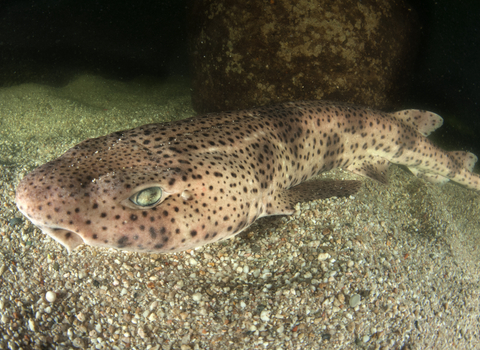
Large-spotted catshark ©Peter Verhoog
Nursehound
The nursehound is a nocturnal predator, hunting smaller fish close to the seafloor.
Scientific name
Scyliorhinus stellarisWhen to see
Present all year round.Species information
Statistics
Length: Up to 160 cmThe nursehound is listed as Near Threatened by the IUCN Red List.
Habitats
About
Nursehounds like to stay close to the sea floor, living in rocky areas with lots of algae. They hunt at night, feeding on cephalopods (like squid and octopus), crustaceans (like crabs and large shrimp), smaller fish and even other sharks.During the day they hide in holes and crevices in the rock, with several sharks sometimes resting in the same crevice.
The nursehound is also known as the greater-spotted catshark, bull huss, greater-spotted dogfish, and rough hound shark – that’s a lot of names for one species!
How to identify
The nurseshound is a large catshark, long and slender but quite stocky towards the front. It has large spots all over its body, and nasal flaps that fall just short of the mouth.Distribution
Found all around the UK.In our area
This species is found around the UK throughout the whole year, primarily around Southern Ireland and Britain. If you're lucky enough to spot a Nursehound they are shown to be more abundant in the Irish Sea around Autumn time hanging out just above the seafloor in shallow waters!
Did you know?
Nursehounds lay their eggs amongst seaweed. The egg cases have curly tendrils that wrap around the seaweed to prevent the egg case from floating away.This species is found around the UK throughout the whole year, primarily around Southern Ireland and Britain. If you're lucky enough to spot a Nursehound they are shown to be more abundant in the Irish Sea around Autumn time hanging out just above the seafloor in shallow waters!

